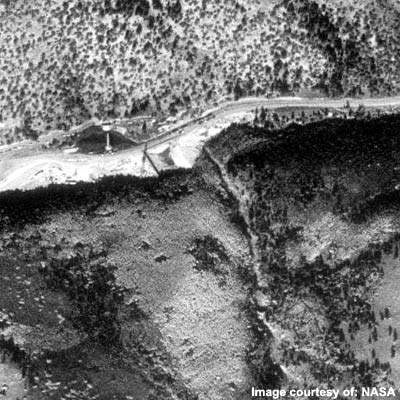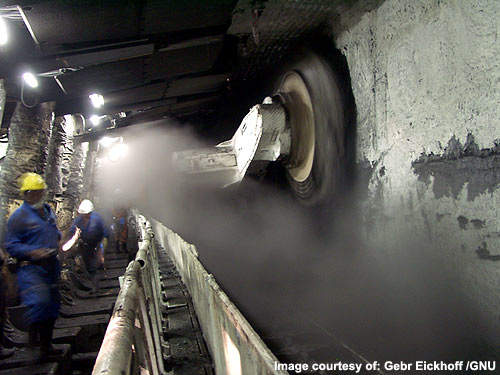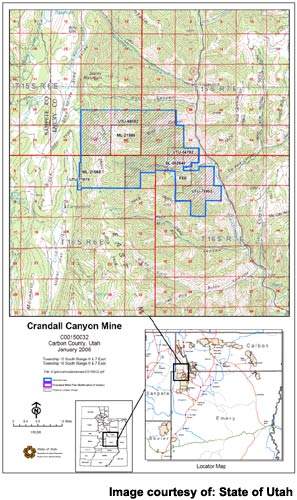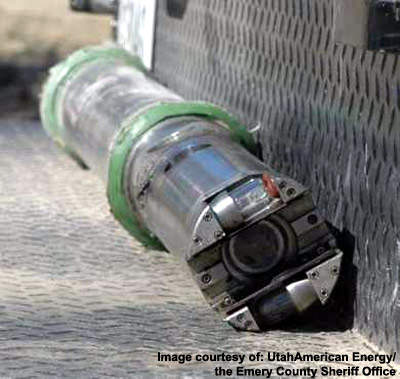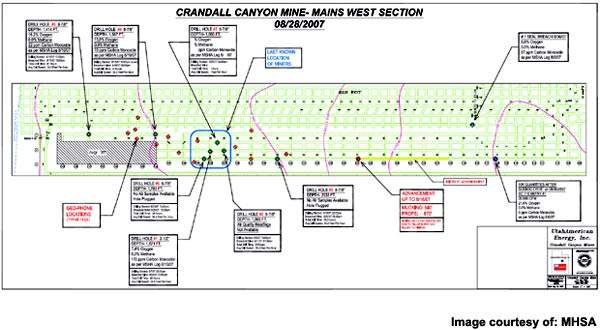At the end of August 2007, with all efforts having failed to locate the miners missing in the Crandall Canyon mine for more than three weeks – and presumed dead – the US Department of Labor announced an independent investigation to look into the handling of the disaster.
The coal mine is located in the north-west of Emery County, 35 miles south-east of Fairview and 15 miles west north-west of Huntington, just off Utah State Route 31 and surrounded by the Manti-LaSal National Forest. The mine permit area extends to over 5,000 acres and occupies fee land as well as federal and state leases, with surface operations being carried out on around ten acres of disturbed land within the forest.
The co-owners of the mine are the Intermountain Power Agency (IPA) and UtahAmerican Energy (formerly Andalex Resources) a subsidiary of the Murray Energy Corporation, with Genwal Resources – the operating division of UtahAmerican – responsible for running it.
Geology and reserves
The mine is in the Wasatch Plateau coal field, which is characterised by fine to medium grain late Cretaceous grey sandstone, inter-bedded with subordinate light and dark grey carbonaceous shales and coal, with continental and transitional sediments. Further marine sediments lie below the main deposits.
Three major fault zones were defined within this coal field, running in a north-south direction – products of a high angle block fault with extensive minor fracturing within the graben. The trends of these faults have a complex pattern, which cause difficulties for mining efforts in the affected areas. The South Crandall Hiawatha seam, for example, holds up to 12.7Mt of potentially mineable reserves, but the difficult geology and the thin lenticular coal seam makes getting it out very difficult.
The mine produced 1.7Mt in 2006 and has an estimated recoverable reserve of 13Mt.
Mining
Mining began at the Crandall Canyon site in November 1939 and continued using a room and pillar method until September 1955. In 1983, the Genwal Coal Company resumed mining operations, producing an annual total of between 90-210,000t of coal, and in 1989, NEICO purchased the mine. IPA bought a 50% interest the following year. The company sold its 50% stake in the Crandall Canyon mine and West Ridge Project to Andalex Resources (now known as Utah American Energy) in July 2010.
A continuous haulage system was incorporated into the room and pillar method in 1991, which enabled production to rise to 1–1.5Mtpa. The mine was transferred to Genwal Resources in March 1995 and a longwall system was subsequently installed, which effectively doubled the mine’s capacity.
A second new longwall was put in place two years later to raise the capacity to 3.5Mtpa. A new loadout facility was built at the mine to handle the increased capacity. In 2004, a new low-profile longwall machine – able to cut coal in a seam little more than 5ft (1.5m) thick – was installed.
The collapse
On Monday 6 August 2007, the mine collapsed, trapping six miners including Kerry Allred (58), Luis Hernandez (23), Brandon Phillips (24), Carlos Payan (22), Manuel Sanchez (41) and Don Erickson (50) 1,500ft (460m) underground, some 3.5 miles (5.5km) from the entrance. The shock waves registered 3.9 to 4.0 by seismographic stations in Utah and Nevada, leading to an initial belief that the collapse had been caused by an earthquake.
However, it appears that the collapse happened while miners were engaged in retreat mining – the final stage of a room and pillar operation when the pillars of coal used to hold up an area of the roof are intentionally removed to allow the last of the coal to be recovered.
It is an established method of mining, but it is a particularly hazardous one. According to studies by the US National Institutes of Occupational Safety and Health, retreat mining is one of the biggest causes of mine-roof-collapse deaths. Although it accounts for only around 10% of underground coal production, a coal miner is more than three times more likely to be fatally injured by a roof collapse when engaged in this type of mining than any other.
Rescue teams were dispatched immediately and began the work of assessing the damage to the mine structure and clearing rubble. On the 9 August, a 2.5in (6cm) hole was bored 1,800ft (549m) towards where the miners were assumed to be trapped. A microphone was lowered and though it did not register any activity, initial samples suggested the air was breathable. Unfortunately, it was later to be established that it was not.
A second and larger hole was made at another possible location and a camera used – revealing mining equipment but no miners. A third bore hole was created near to the ventilation area, followed by a fourth targeted towards noises that geophones briefly detected coming from the mine for five minutes on the evening of 15 August.
By noon the following day – now 11 days after the collapse – underground rescue teams were able to advance around halfway through the rubble; at 6.30 that evening, one of the tunnel walls burst, collapsing the mine again killing three of the rescuers and injuring six others. The remaining rescue teams were pulled from the mine.
The fifth, sixth and eventually – at the end of August – seventh bore holes also failed to find either signs of life, or the bodies of the missing miners.
Inevitably there was much criticism voiced, especially of the mine’s owners for ignoring prior safety warnings and the US Mine Safety and Health Administration both for its handling of events and for allowing retreat mining in the first place.
With the members of the independent investigation panel – Ernest C. Teaster Jr. and Joseph W. Pavlovich – named at the beginning of September 2007, the process of working out exactly what went so tragically wrong can get underway.
The US Government concluded the enquiry in July 2008, imposing the highest penalty of $1.85m against Genwal Resources for 2007 Collapse under the Coal Mine Safety Violations Act.
The future
The future of the mine seems uncertain and the Utah mining community remains divided over the issue of re-opening it. Murray Energy vice president Rob Moore is reported to have said that the company expected to resume operations "at some point" to access the recoverable coal in other parts of the mine. However, Robert E. Murray, the CEO of Murray Energy, stated that he filed the necessary paperwork with federal regulators to permanently close and seal the Crandall Canyon mine.
Even before the disaster, although further federal leases were to extend the useful life of the mine and new access ways planned on the south side, the owners had made it clear to the state of Utah that it was their intention that the mine would close in 2008.

